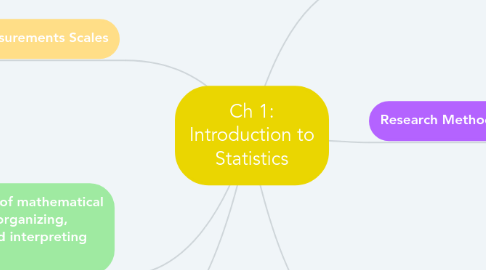Ch 1: Introduction to Statistics
John Simmonsにより


1. Statistical Methods
1.1. Inferential Statistics: uses sample data to make inferences about populations
1.2. Descriptive Statistics: Organizes, summarizes, and simplifies data
2. Statistics: A set of mathematical procedures for organizing, summarizing and interpreting data
2.1. Population: set of all individuals of all interests in a particular study
2.1.1. Parameter - a value, usually numerical, that describes a population
2.1.1.1. Sampling Error: error that exists between a sample statistic and the corresponding population parameter
2.2. Sample: a set of individuals selected from a population
2.2.1. Statistic - a value, usually numerical, that describes a sample
3. Measurements Scales
3.1. Nominal: a set of categories that have different names; label and categorize observations
3.2. Ordinal: set of categories organized in an ordered sequence; rank observations in terms of size or magnitude
3.3. Interval: ordered categories that are all intervals of exactly the same size; no true zero
3.4. Ratio: an interval scale with an absolute zero point
4. Variables: a characteristic or condition that changes or has different values for different individuals
4.1. Discrete Variable: separate indivisible categories
4.2. Continuous Variable: Infinite possible values between any two observed values
4.2.1. Real Limits: boundaries of intervals represented on a continuous number line
4.2.1.1. Upper Real Limits
4.2.1.2. Lower Real Limits
5. Research Methods
5.1. Correlational Method: examines the relationship between two variables but cannot show causation
5.2. Experimental Method: Manipulation of one variable to observe the effects on another variable to show cause-and-effect
5.2.1. Dependent Variable = observed
5.2.2. Independent Variable = manipulated
5.2.3. Control Condition = no treatment
5.2.4. Experimental Condition = treatment
